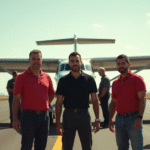Introduction
In today’s world, food safety, security, and traceability are paramount, not just for the health of humans and animals in producing and consuming countries but also due to fierce global competition. Good sanitary conditions provide competitive advantages, and sometimes are used for protectionist reasons.
The Growing Population and Food Production Challenges
With the constant growth of the global population, countries face pressure to ensure sufficient food production. The challenge is not only about quantity but also ensuring the food is safe and of high quality.
Global Mobility and Risk of Pests and Diseases
The extensive movement of people and goods worldwide poses a significant risk for the introduction of exotic pests and diseases. Daily, around 120,000 commercial flights take off and land globally, with the number exceeding 213,000 when private flights are included—meaning over 80 planes depart or arrive every minute somewhere on Earth.
The Spread of Pests and Diseases
These 22,000 flights carry approximately 3 million passengers who may unknowingly transport fruits, meats, cheeses, vegetables, plants, pets, or seeds that can spread diseases and pests if not detected upon arrival at their destinations. The same applies to the movement of goods and products across borders and ports.
The Cattle Warble Fly Infestation in Mexico
The cattle warble fly (CFB) infestation affects bovine, porcine, and equine species—sometimes even humans. The parasites are actually larvae of a fly that lays eggs in open wounds, feeding on the tissue from within and causing weight loss that can eventually lead to death due to infections.
Controlling the Cattle Warble Fly
Since it’s not a contagious disease, the best way to control it is by producing sterile flies in specialized facilities and releasing them to disrupt the parasite’s reproductive cycle.
The Resurgence of the Cattle Warble Fly Epidemic
After successfully eradicating the CFB in Mexico and Central America by 1991, Panama was strategically chosen to contain the pest through sterile fly releases funded by the United States. This method effectively controlled the fly population in Panama until 2023.
Reintroduction and Spread
In 2023, the CFB started re-entering Panama, likely due to uncontrolled migration of South American migrants through the Darien Gap along the Panama-Colombia border, possibly carrying contaminated meat or pets.
Containing the Pest
During my tenure at SADER, in collaboration with SENASICA experts and technicians, we devised a technical plan to contain the CFB as far from Mexico’s border with Guatemala and Belize as possible. We met with agriculture ministers from Central America and the Dominican Republic in April 2024 to propose a coordinated strategy against the fly’s advance along Costa Rica’s border with Nicaragua.
Delays and Spread
Unfortunately, the International Regional Sanitary Organization (OIRSA) responsible for regional sanitation in Central America and the Dominican Republic delayed operations, allowing the fly to spread from Nicaragua to Honduras and eventually Guatemala and Mexico, where it was first detected in late November 2024.
Addressing the Challenge
Mexico’s vulnerability to CFB was imminent, exacerbated by the legal and illegal cattle trade from Central America to Mexico over the past few decades, with more than one million heads annually.
Collaborative Efforts
SENASICA cannot stop illegal cattle smuggling alone; it requires coordinated efforts with all border entities, primarily the National Guard, and a joint strategy with our southern neighbor to tackle corruption and organized crime in both countries.
Regional Cooperation
The CFB issue isn’t new, but gained prominence when US authorities started blocking Mexican cattle movement across the border, despite the problem remaining localized in Mexico’s southwestern region. The main concern is that flies will continue traveling north until they encounter colder climates unless immediate action is taken.
Intensifying Sterile Fly Releases
Controlling the CFB requires a regional, coordinated effort from the seven Central American and three North American countries, involving public officials, specialist technicians, and crucially, ranchers. While measures can control cattle or human/pet movement, flies don’t need permission or passports to travel between countries.
Eradication Timeline and Resources
Eliminating CFB from the region again could take 10 to 15 years with coordinated, firm political and financial commitment. Such a program would require substantial economic investment, strong technical leadership, and regional organization participation like OIRSA, FAO, and IICA.
Leadership and Responsibility
Mexico is well-positioned to lead this effort, having successfully eradicated CFB once before and gained valuable experience. It’s crucial to raise awareness and accept responsibility for tackling this regional challenge.






